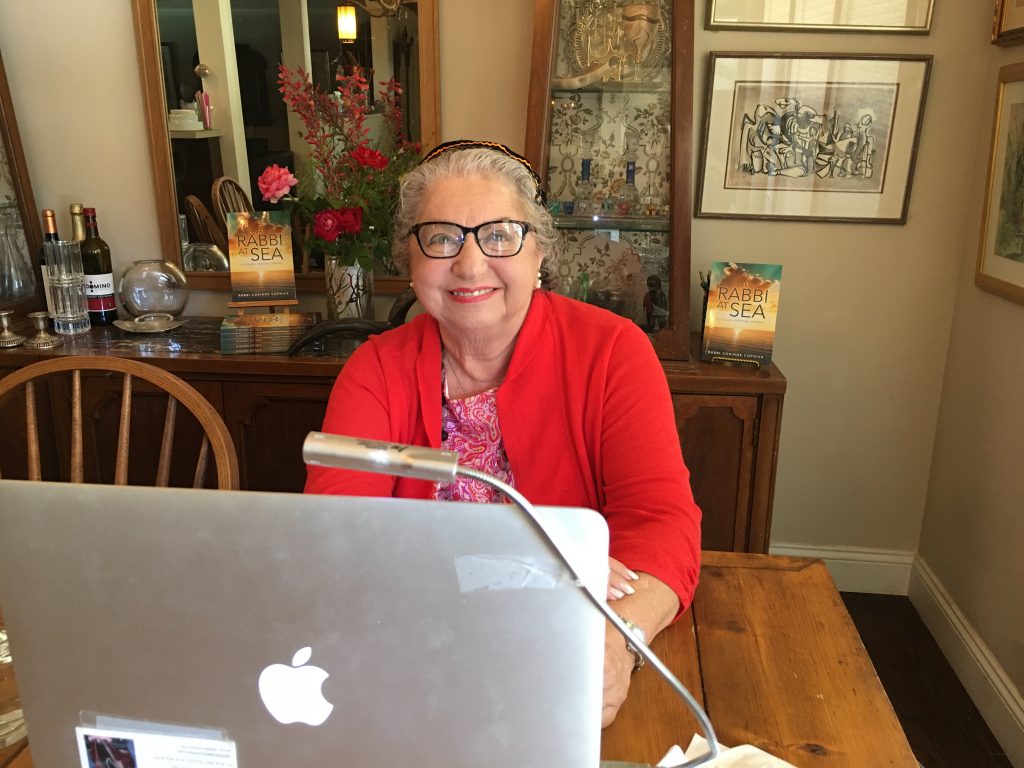By Rabbi Corinne Copnick

Over the past view months, Zoom online programming has been my window to the outside world. As it has with many of you, this new technology has made the viewpoints of my colleagues and friends available to me in these difficult pandemic times. I have learned so much from the thinking process and knowledge of others and offered my own as well. It has enabled me to see friendly faces I know, as well as those new to me, in mosaic tiles. And on Zoom, we can actually “see” one another, full face, for a while. We don’t need masks when we’re on the screen.
As a senior citizen in my eighties, I have the good fortune to live with two of my grown children and now a grandchild home from college as well. I do not have to watch television or have a Sabbath dinner alone. We have a beautiful garden in which to relax and have family meals outside. However, as a diabetic for the last 25 years, I do have a compromised immune system. So I have listened faithfully to the advice of our California government and our dedicated health experts and remained indoors since the beginning of March. It’s going on five months now. Apart from a daily walk around the block or so, and one quick visit to the beach on a day that it was “open,” I have not been “outside” since the “stay safe at home” instruction was issued.
At first I watched a lot of television, especially the daily comments of New York governor Andrew Cuomo, whose service to our nation has been invaluable. As a family, we caught up on recent TV series with “binge-watching.” We cooked and baked a lot. Courtesy of the Los Angeles library, I have read some thirty or so books online. Good books. I visited my doctor for an online appointment.
Perhaps most important, I have included in my daily schedule attending at least one Zoom lecture or teaching on a particular topic every single day. When it became too overwhelming—and tiring as well, because learning on Zoom requires a constant, single-focus attention, I restricted my Zoom screen time to one lecture a day. Gradually, I developed the confidence to successfully host and teach ten of my own sessions for my Beit Kulam adult education classes.
And I am proud to have mastered, at least to some small extent, and an online class helped, a new technology that can be a very “cold” medium for teaching—unless you learn how to make it “warm.” Recorded lectures tend to be on the cold side, and I have found that it’s best to have shorter bursts of “teaching,” with a lot of discussion, or guided discussion, in between.
Also, I find it takes away from concentration on what the main speaker is saying to have written material, or even visual material, on the screen while the speaker is talking. Better, in my experience, to use it, as an aid to discussion, before or after the topic at hand. At the moment, I’m not an enthusiast of the breakaway groups feature; so far, I have found this “small group” discussion experience rather limited in the time allowed. Still much to be learned about using it, so this reaction may change.
When I virtually presented my new book, “A Rabbi at Sea” in New York for the Jewish Book Council network, I saw how meticulous preparation and engagement could make a large scale event very successful. Where there’s a will—and a need that could otherwise be overwhelming—there’s a way!

* * * *
In the meantime, I have made myself available to my Beit Kulam members, should they have the need to talk about personal issues, on Friday mornings, and on Friday afternoons I virtually teach a private Torah class to my own daughter (I have four of them) and her non-Jewish partner in Vancouver. It has proved to be both a beautiful and calming experience before greeting Shabbat. Their “homework” is to read various commentaries about each week’s parsha before we read it aloud together. This past week we gave the gift of increasing strength to one another by reciting the traditional “Hazak, hazak, v’nitkazek” as the Book of Numbers ended and began Deuteronomy, the last book in the Torah, which largely summarizes what has happened in the previous four books.
So, for some people, the new technologies drive them nuts. For me, it has been a wonderful way to preserve my sanity amidst the labyrinth of dark and conflicting news broadcasts that now permeate our wonderful world. For me, the new technologies, bringing with them exposure to many points of views, are a saving grace. Can I help it if I’m naturally hopeful and optimistic?
I remember the devastating polio epidemic of my youth that so badly affected my mother’s cousin, Libbele, that she was paralyzed from the waist down for the rest of her life, confined to a wheelchair. But she had an indomitable spirit. She mastered many crafts, through which she made a small living, and her loving relatives made sure she was well supported, emotionally and financially, throughout her life.
Like the many other pandemics that permeate our world history (one of the four disasters that the Jewish holiday, Tisha B’Av, memorializes is the plague that killed 24,000 students of Rabbi Akivah), polio was eventually overcome (even though late age, second stage polio has unexpectedly entered our world) when Dr. Salk developed a vaccine. As I write this, our scientists around the world are working furiously to find the right vaccine to overcome Covid-19. With God’s help, they will. As Dr. Salk is famously quoted, “Hope lies in dreams, in imagination and in the courage of those who dare to make dreams into reality (www.salk.edu).”